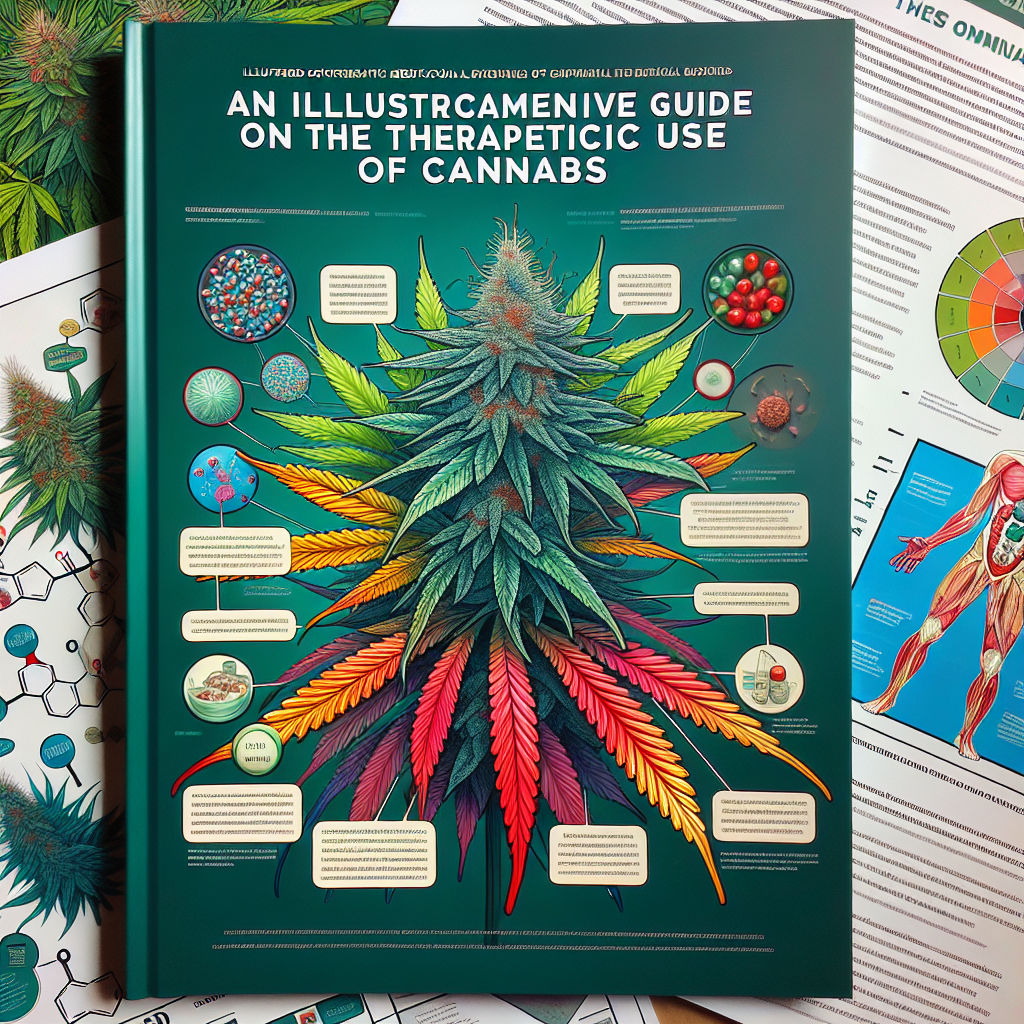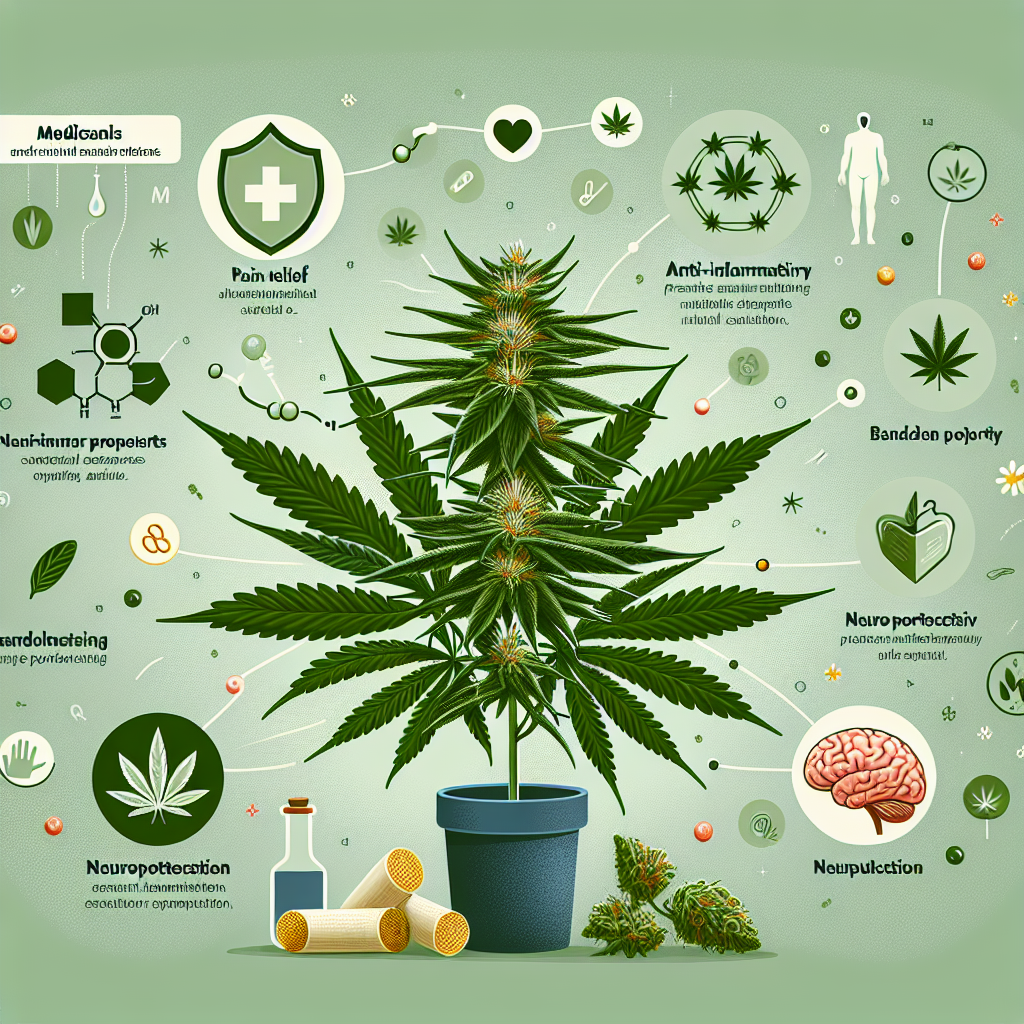“The Therapeutic Use of Cannabis: A Comprehensive Guide” delves into the multifaceted world of cannabis as a medicinal tool, exploring its historical roots, pharmacological properties, and contemporary applications. This guide provides an in-depth analysis of the therapeutic potential of cannabis, examining its efficacy in treating a variety of conditions such as chronic pain, epilepsy, anxiety, and more. It also addresses the legal landscape, safety concerns, and the latest research findings, offering a balanced perspective on the benefits and limitations of cannabis therapy. Designed for healthcare professionals, patients, and anyone interested in the medical use of cannabis, this comprehensive resource aims to educate and inform, fostering a deeper understanding of this complex and often controversial plant.
Understanding The Medical Benefits Of Cannabis
Cannabis, often referred to as marijuana, has been a topic of significant debate and research over the past few decades. As more states and countries move towards legalization, understanding the medical benefits of cannabis becomes increasingly important. This plant, which has been used for centuries in various cultures for its medicinal properties, is now being recognized by modern science for its potential therapeutic uses.
One of the primary reasons cannabis is gaining acceptance in the medical community is its ability to alleviate chronic pain. Chronic pain affects millions of people worldwide, and traditional pain medications, such as opioids, often come with severe side effects and the risk of addiction. Cannabis, particularly its compounds known as cannabinoids, offers a promising alternative. Cannabinoids like THC (tetrahydrocannabinol) and CBD (cannabidiol) interact with the body’s endocannabinoid system, which plays a crucial role in regulating pain. By modulating this system, cannabis can provide significant pain relief without the harsh side effects associated with conventional painkillers.
In addition to pain management, cannabis has shown potential in treating a variety of other medical conditions. For instance, it has been found to be effective in reducing the frequency and severity of seizures in individuals with epilepsy. This is particularly true for CBD, which has been the focus of numerous studies and has even led to the development of FDA-approved medications like Epidiolex. The anti-seizure properties of CBD have provided hope for many patients who have not responded well to traditional treatments.
Moreover, cannabis has demonstrated benefits in the realm of mental health. Anxiety and depression are prevalent mental health disorders that can significantly impact an individual’s quality of life. While traditional medications like antidepressants and anxiolytics are commonly prescribed, they do not work for everyone and can have undesirable side effects. Cannabis, particularly strains high in CBD, has been found to have anxiolytic and antidepressant effects. By interacting with serotonin receptors in the brain, CBD can help regulate mood and reduce symptoms of anxiety and depression.
Furthermore, cannabis has been used to alleviate symptoms associated with cancer and its treatments. Chemotherapy, a common cancer treatment, often causes nausea and vomiting, which can be debilitating for patients. Cannabis, especially THC, has been shown to be effective in reducing chemotherapy-induced nausea and vomiting. Additionally, cannabis can stimulate appetite, which is beneficial for cancer patients who often experience a loss of appetite and significant weight loss.
Another area where cannabis shows promise is in the treatment of neurodegenerative diseases such as Alzheimer’s and Parkinson’s. Research suggests that cannabinoids have neuroprotective properties, which means they can help protect brain cells from damage. This is particularly important in diseases like Alzheimer’s, where the progressive loss of brain cells leads to cognitive decline. While more research is needed, early studies indicate that cannabis could potentially slow the progression of these diseases and improve the quality of life for patients.
As we continue to explore the medical benefits of cannabis, it is essential to approach this topic with an open mind and a commitment to scientific inquiry. While cannabis is not a cure-all, its potential to provide relief for a wide range of conditions is undeniable. By understanding how cannabis works and its therapeutic applications, we can better appreciate its role in modern medicine and offer patients more options for managing their health.
Exploring Different Cannabis Strains For Therapeutic Use

When exploring the therapeutic use of cannabis, understanding the different strains available is crucial for achieving the desired medicinal effects. Cannabis strains are generally categorized into three main types: Indica, Sativa, and Hybrid. Each of these strains has unique properties and effects, making them suitable for various therapeutic applications. By delving into the characteristics of these strains, patients and healthcare providers can make informed decisions about which type of cannabis may be most beneficial for specific conditions.
Indica strains are often associated with a calming and sedative effect, making them ideal for evening use or for individuals seeking relief from insomnia, anxiety, and chronic pain. These strains typically have higher levels of CBD (cannabidiol) and lower levels of THC (tetrahydrocannabinol), which contribute to their relaxing properties. Patients suffering from muscle spasms, arthritis, or other conditions that cause physical discomfort may find Indica strains particularly helpful. Additionally, the soothing effects of Indica can aid in reducing stress and promoting a sense of overall well-being.
On the other hand, Sativa strains are known for their uplifting and energizing effects, making them suitable for daytime use. These strains usually have higher levels of THC and lower levels of CBD, which can enhance mood, creativity, and focus. For individuals dealing with depression, fatigue, or attention deficit disorders, Sativa strains can provide a much-needed boost in energy and mental clarity. Moreover, the stimulating properties of Sativa can help alleviate symptoms of nausea and increase appetite, which is beneficial for patients undergoing treatments such as chemotherapy.
Hybrid strains, as the name suggests, are a combination of Indica and Sativa strains, offering a balanced mix of effects. These strains can be tailored to meet specific therapeutic needs by adjusting the ratio of Indica to Sativa. For instance, a Hybrid strain with a higher Indica content may be more suitable for pain relief and relaxation, while a Hybrid with a higher Sativa content may be better for enhancing mood and energy levels. This versatility makes Hybrid strains a popular choice for patients seeking a more customized approach to their treatment.
In addition to the primary categories of Indica, Sativa, and Hybrid, it is essential to consider the terpene profile of a cannabis strain. Terpenes are aromatic compounds found in cannabis that contribute to its flavor, aroma, and therapeutic effects. Different terpenes can have varying impacts on the body and mind. For example, the terpene myrcene is known for its sedative properties and is commonly found in Indica strains, while limonene, which has uplifting and anti-anxiety effects, is often present in Sativa strains. By understanding the terpene profile of a strain, patients can further refine their choices to better suit their therapeutic needs.
As the therapeutic use of cannabis continues to gain acceptance and research advances, the availability of different strains and their specific applications will likely expand. It is important for patients to consult with healthcare professionals who are knowledgeable about cannabis to determine the most appropriate strain and dosage for their condition. By exploring the diverse world of cannabis strains, individuals can find effective and natural relief for a wide range of ailments, ultimately improving their quality of life.
Safe Consumption Methods For Medical Cannabis
When it comes to the therapeutic use of cannabis, understanding safe consumption methods is crucial for maximizing benefits while minimizing potential risks. As medical cannabis gains acceptance and popularity, patients and healthcare providers alike are exploring various ways to consume it effectively and safely. Each method of consumption has its own set of advantages and considerations, making it essential to choose the one that best suits individual needs and medical conditions.
One of the most common and traditional methods of consuming medical cannabis is smoking. While smoking provides rapid relief due to the quick absorption of cannabinoids into the bloodstream through the lungs, it also comes with potential respiratory risks. For patients with pre-existing lung conditions or those concerned about the long-term effects of inhaling smoke, alternative methods may be more appropriate.
Vaporization, or vaping, is often recommended as a safer alternative to smoking. By heating cannabis to a temperature that releases cannabinoids without burning the plant material, vaporization reduces the intake of harmful toxins and carcinogens. This method still offers the advantage of fast-acting relief, making it suitable for patients who need immediate symptom management. However, it is important to use high-quality vaporizers and cannabis products to avoid exposure to harmful additives.
For those who prefer not to inhale cannabis, oral consumption methods such as edibles and tinctures provide a discreet and smoke-free option. Edibles, which include a wide range of products like gummies, chocolates, and baked goods, offer a longer-lasting effect compared to inhalation methods. However, the onset of effects can be delayed, sometimes taking up to two hours, which requires careful dosing to avoid overconsumption. Starting with a low dose and waiting to gauge the effects is a prudent approach for new users.
Tinctures, which are liquid cannabis extracts, can be taken sublingually (under the tongue) for faster absorption or added to food and beverages. Sublingual administration allows cannabinoids to enter the bloodstream more quickly than edibles, providing a middle ground between the rapid effects of inhalation and the prolonged effects of edibles. This method also allows for precise dosing, making it easier for patients to find their optimal therapeutic dose.
Topical applications, such as creams, balms, and patches, offer another non-invasive method of consuming medical cannabis. These products are applied directly to the skin and are particularly effective for localized relief of pain, inflammation, and skin conditions. Since topicals do not enter the bloodstream, they do not produce psychoactive effects, making them an attractive option for patients seeking symptom relief without the “high” associated with other forms of cannabis.
In addition to these methods, some patients may benefit from using cannabis oils or capsules, which provide a controlled and consistent dose. Oils can be ingested directly or used in cooking, while capsules offer a convenient and familiar form of medication. Both options are ideal for patients who require precise dosing and long-lasting effects.
Ultimately, the choice of consumption method should be guided by individual preferences, medical needs, and the advice of a healthcare professional. By understanding the various options available and their respective benefits and drawbacks, patients can make informed decisions that enhance their therapeutic experience with medical cannabis. As research continues to evolve, new and innovative methods of consumption are likely to emerge, further expanding the possibilities for safe and effective medical cannabis use.
Legal Considerations And Regulations For Medical Cannabis Use
Navigating the legal landscape of medical cannabis can be a complex endeavor, but understanding the regulations and considerations is crucial for both patients and healthcare providers. The therapeutic use of cannabis has gained significant traction in recent years, with many countries and states recognizing its potential benefits for a variety of medical conditions. However, the legal framework surrounding its use varies widely, making it essential to be well-informed about the specific laws in your region.
To begin with, it is important to note that the legality of medical cannabis is not uniform across the globe. In some countries, such as Canada and Germany, medical cannabis is federally legal and regulated, allowing patients to access it through a prescription from a licensed healthcare provider. Conversely, in the United States, the legal status of medical cannabis is determined at the state level, leading to a patchwork of regulations that can be confusing to navigate. While over 30 states have legalized medical cannabis, it remains classified as a Schedule I substance under federal law, which complicates matters further.
Given this disparity, patients and healthcare providers must be diligent in understanding the specific requirements and restrictions in their jurisdiction. For instance, in states where medical cannabis is legal, patients typically need to obtain a medical cannabis card, which involves a certification from a qualified physician. This certification process often requires a thorough evaluation of the patient’s medical history and condition to determine if they qualify under the state’s list of approved medical conditions. Commonly approved conditions include chronic pain, epilepsy, multiple sclerosis, and certain types of cancer, among others.
Moreover, the regulations governing the cultivation, distribution, and possession of medical cannabis also vary. Some states allow patients to grow a limited number of cannabis plants for personal use, while others strictly prohibit home cultivation. Dispensaries, which are licensed to sell medical cannabis, must adhere to stringent guidelines regarding product quality, labeling, and security. Patients should ensure they are purchasing from reputable dispensaries to guarantee the safety and efficacy of their medication.
Another critical aspect to consider is the potential legal implications of using medical cannabis, especially in relation to employment and driving. Many employers have drug-free workplace policies, and despite the legal status of medical cannabis in some states, employees may still face disciplinary action or termination if they test positive for THC, the psychoactive component of cannabis. It is advisable for patients to discuss their medical cannabis use with their employer and understand their company’s policies to avoid any legal complications.
Similarly, driving under the influence of cannabis is illegal and can result in severe penalties. Patients must be aware of how cannabis affects their ability to operate a vehicle and should refrain from driving if they feel impaired. Law enforcement agencies are increasingly equipped with tools to detect cannabis impairment, and being informed about the legal limits and consequences is essential for responsible use.
In conclusion, while the therapeutic use of cannabis offers promising benefits for many patients, navigating the legal considerations and regulations requires careful attention and due diligence. By staying informed about the specific laws in their region, patients and healthcare providers can ensure they are compliant with legal requirements and can safely and effectively incorporate medical cannabis into their treatment plans. As the legal landscape continues to evolve, ongoing education and awareness will be key to maximizing the therapeutic potential of cannabis while minimizing legal risks.
Q&A
1. **What are the primary therapeutic uses of cannabis?**
– Pain management, reduction of inflammation, control of nausea and vomiting (especially in chemotherapy patients), appetite stimulation, and treatment of certain neurological disorders such as epilepsy and multiple sclerosis.
2. **What are the main active compounds in cannabis that contribute to its therapeutic effects?**
– The main active compounds are cannabinoids, primarily tetrahydrocannabinol (THC) and cannabidiol (CBD).
3. **What are some potential side effects of using cannabis for therapeutic purposes?**
– Potential side effects include dizziness, dry mouth, altered mental state, impaired memory and concentration, increased heart rate, and potential dependency.
4. **How is medical cannabis typically administered for therapeutic use?**
– Medical cannabis can be administered through various methods including inhalation (smoking or vaporizing), oral ingestion (edibles, capsules, tinctures), topical application (creams, lotions), and sublingual administration (oils or sprays placed under the tongue).
Conclusion
In conclusion, “The Therapeutic Use of Cannabis: A Comprehensive Guide” provides an in-depth exploration of the medicinal benefits, potential risks, and regulatory landscape of cannabis. It highlights the growing body of scientific evidence supporting cannabis’s efficacy in treating various medical conditions, such as chronic pain, epilepsy, and multiple sclerosis, while also addressing concerns related to dependency, mental health, and legal issues. The guide underscores the importance of informed decision-making and personalized treatment plans, advocating for continued research and education to optimize the therapeutic use of cannabis.



















